
When you are going to explore the most famous hiking trails located in the different mountain ranges in the Andes, it is almost mandatory to take one of the best trekkin poles since the terrain is very steep and slippery, which with a minimum miscalculation of the steps could fall or slip. As is known, the Andes are located at altitudes of more than 4,000 meters where breathing is more difficult and a good trekking pole will give you extra energy to continue your adventure.
Trekking poles, also known as trekking poles or walking poles, trekking poles can provide stability and balance on the trail. They also reduce the chance of hip, back, knee or ankle injuries. This is because, when in use, they give us at least two to three points of contact with the ground at any one time, helping to distribute our weight. When transporting heavier or multi-day loads. As the terrain becomes more uneven, its practicality increases even more. When the trail ends, poles can help support your entire body as you navigate the bumps and potholes.
Trekking poles have long been considered an essential piece of gear for hikers and backpackers for their stability and support while trekking up and down with a loaded backpack. They help you walk and keep your balance on steep hills, rocky paths, and slippery snow-covered trails. They are made of different materials, come in different designs, and of course some are more expensive than others. We’ve tested a ton of popular options, taking them on runs, hikes, climbs, and scrambles to find the best trekking poles for all your outdoor adventures.
Average Price: $190
Weight (pair): 9.8 oz.
Shaft Material: Carbon Fiber
Pole Material: Carbon fiber shafts, EVA foam grip
Collapsed Length: 13-17 in.
Pros: Ultralight, small collapsed length
Cons: Pricey and carbon is more brittle than aluminum.
The Black Diamond Distance Carbon Z trekking/running poles are considered the best trekking poles among many trail runners and ultra runners. Their simple, lightweight design is strong and reliable, making them a great choice for long days in the mountains. The poles feature 100% carbon fiber shafts with reinforced joints to improve rigidity and durability. A simple push button lock mechanism makes extending and folding the pole quick and easy. When not in use, the poles quickly collapse into three parts and fold flat parallel, allowing for safe storage in or on your pack.
The poles are available in a variety of lengths in two-inch increments, from 40 inches to 51 inches between unisex and women’s versions, so they should fit runners between four feet and 10 inches tall to around six feet. and four inches.
The straps are simple, lightweight, moisture-wicking loops that are easy to take on and off, making aid stations and snacks a breeze. These are attached to a comfortable EVA foam grip that provides enough cushioning without compromising grip security, especially in cold or wet conditions. These poles also come with interchangeable rubber and carbide tips and are compatible with snow baskets for winter use, making them a versatile addition to your running gear.
The carbon fiber provides a decent amount of shock absorption compared to aluminum shafts, and while the difference is barely noticeable with each step, over time, you will notice the improved comfort of using these poles mile after mile. This product is primarily designed to save weight. Carbon fiber shaft construction provides most of the weight savings compared to other trekking poles.
With this walking stick you can comfortably travel the trekking circuits in the Andes such as: Ausangate Trek, Salkantay Trek, Trek to Choquequirao, Quelccaya Glacier Expedition, Lares Trek, Trek through the Inca quarries, Ancascocha Trek, Tour to the ruins of Huchuy Qosqo, the classic Inca trail to Machu Picchu, the Short Inca Trail to Machu Picchu, tours through the Huaraz mountain range, expedition to Patagonia.

Average Price: $ 190 USD
Available Lengths: 105 – 135 cm
Weight (pair): 4.9 oz / 139 g
Pole Material: Carbon fiber shafts, Trail Shark grip system with cork grip
Pros: Lightness, easy folding system
Cons: The grip area is not as extensive as other poles – Price somewhat high compared to other models on the market
The Ultratrail FX.One Superlite will help you in your quest for kilometers and altitude. It comes with the new Trail Shark, the first grip system designed specifically for trail running. Its grip weight has been reduced by 30% compared to the classic Shark system, thanks to newly developed air channels. The Shark’s webbing strap fits like a glove and delivers power directly to the pole’s core.
The Shark’s slim design allows you to slip the leash in and out even with your eyes closed. A kind of additional nose on the grip offers a second grip option and even more precise handling. The cane can be easily folded and carried in the hands. Its compact diameter of 14/12 millimeters guarantees a firm grip. Thanks to the direct grip between the hand and the pole, the Shark System provides excellent power transfer. Quick insertion and disengagement of the handle is not a problem.
The push button system allows the folding poles to be opened and closed with the push of a button. Minimalist basket for maximum weight savings and optimal rolling behaviour. Lightweight basket and toe combination for optimized vibration control and maximum grip on any surface. It must be remembered that these Leki Ultratrail FX.One Superlite are made of the highest quality carbon. It is a very light material, but at the same time flexible that provides rigidity and dynamism in a balanced way. In this way, the carbon absorbs the blows, preventing the cane from suffering the full impact of the blow and possibly breaking.
With this walking stick you can comfortably travel the trekking circuits in the Andes such as: Ausangate Trek, Salkantay Trek, Trek to Choquequirao, Quelccaya Glacier Expedition, Lares Trek, Trek through the Inca quarries, Ancascocha Trek, Tour to the ruins of Huchuy Qosqo, the classic Inca trail to Machu Picchu, the Short Inca Trail to Machu Picchu, tours through the Huaraz mountain range, expedition to Patagonia.

Average Price: $ 120 USD
Available Lengths: 100 – 140 cm
Weight (pair): 17.1 oz / 486 g
Pole Material: Aluminum 7075, EVA foam
Pros: Strong, Easy to use, Excellent locking mechanism, Beautiful finish, Robust and durable
Cons: They are not the lightest on the market, With the passage of time, some squeaking can be Heard
The Black Diamond Trail is a 3-section aluminium pole, with instantly readable measurements in metric given on the lower two sections, and a good range of height adjustability. The sections are joined using the flick lock system, and tension-adjusted. The foam handle is well suited for medium-sized hands and comes in a single, long piece, with very basic moulding for the bottom of the palm. This allows the user to move the hand up and down the pole when covering uneven terrain. In use, the pole is weighted slightly to the tip, which gives a slight swing in forward motion. The aluminium shafts are strong and do not bend or wobble when under strain.
The E.V.A foam grip very comfortable and breathable. The extra length of the grip and the plastic cup on top gives you many holding options while you’re on the move. The straps are comfortable and soft on the hand, very easy to adjust. The flicklock system is genius. It’s the easiest most reliable locking mechanism on the market. One of the most compact trekking poles out there. It folds down to a small 23 inches and is a great value. This is one of the few trekking poles that fits in a carry on bag (most airlines limit the bag to 22 inches long so these poles fit if packed diagonally).
With this walking stick you can comfortably travel the trekking circuits in the Andes such as: Ausangate Trek, Salkantay Trek, Trek to Choquequirao, Quelccaya Glacier Expedition, Lares Trek, Trek through the Inca quarries, Ancascocha Trek, Tour to the ruins of Huchuy Qosqo, the classic Inca trail to Machu Picchu, the Short Inca Trail to Machu Picchu, tours through the Huaraz mountain range, expedition to Patagonia.
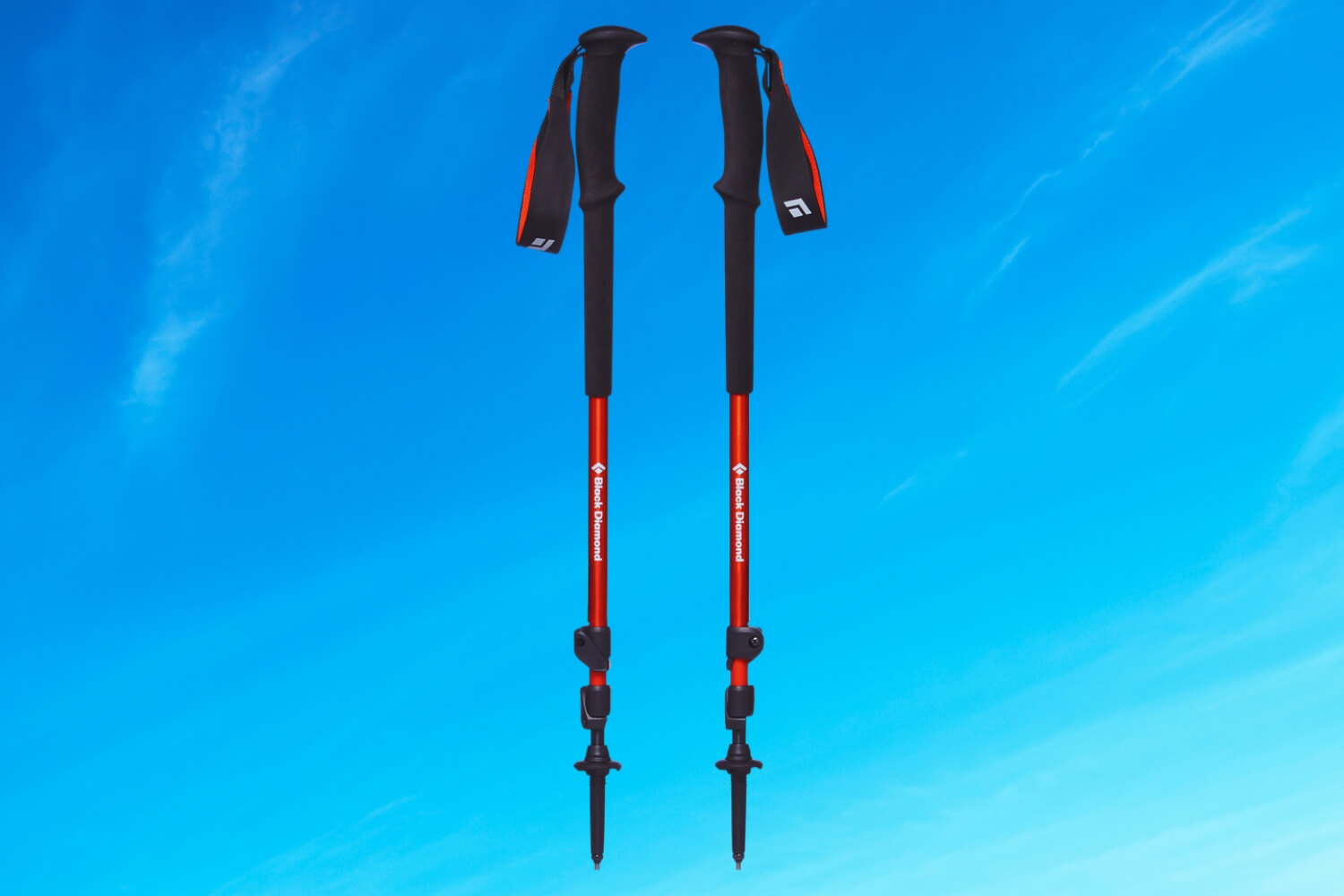
Average Price: $ 54 USD
Available Lengths: 110 – 135 cm
Weight (pair): 19.04 oz / 540 g
Pole Material: 3K carbon and aluminum 7075
Pros: Easy to handle, maximum stability, space-saving and easy to transport
Cons: Not recommended for long expeditions
The Nordic walking poles carbon and aluminum weigh only 270 grams per trekking pole, combination of lightweight 7075 aluminum and 3K carbon ensures the strongest natural suspension – stable hiking poles. The telescopic function of the hiking poles enables stepless height adjustment between 110cm-135cm thanks to the flip-lock quick-release fastener. When folded, its length is 36 cm.
The dual-grip system of the trekking poles, extendable, ultra-light, made of cork, adapts to the shape of the hand and is skin-friendly. Adjustable hand straps for a good grip of the walking sticks. Accessories for the Nordic walking poles are a rubber buffer set, 1x bag (water-repellent) for storing the sticks and 1 pair of Atacama hiking poles, foldable carbon and aluminum. The Nordic walking sticks are versatile in alpine terrain, mountain tours or in the snow. The hiking stick foldable Nordic Walking stick for men and women.
With this walking stick you can comfortably travel the trekking circuits in the Andes such as: Ausangate Trek, Salkantay Trek, Trek to Choquequirao, Quelccaya Glacier Expedition, Lares Trek, Trek through the Inca quarries, Ancascocha Trek, Tour to the ruins of Huchuy Qosqo, the classic Inca trail to Machu Picchu, the Short Inca Trail to Machu Picchu, tours through the Huaraz mountain range, expedition to Patagonia.

Average Price: $ 174 USD
Available Lengths: 115 – 135 cm
Weight (pair): 17.42 oz / 494 g
Pole Material: Alloy, Carbide, Carbon, EVA, PA, Titanal, Alu 7075 T6
Pros: Foldable, Auto-latching, Ergonomic and soft foam grip, Hybrid construction: carbon, alu
Cons: Something expensive
The Pedroc Carbonium Pro is a lightweight, compact and robust hybrid construction auto-latching, foldable carbon pole with height adjustment for speed hiking in varied terrain. The bottom section from high-strength Titanal aluminium alloy to cope with rocks and scree, and it’s also fitted with a hardwearing carbide tip. The ergonomic EVA foam handle allows a range of positions in uneven terrain and the padded sling ensures full comfort. The aluminium-reinforced Trust-Lock system ensures reliable locking and fast adjustment. It also has a very compact pack size (42 cm). Fitted with an exchangeable basket.
With this walking stick you can comfortably travel the trekking circuits in the Andes such as: Ausangate Trek, Salkantay Trek, Trek to Choquequirao, Quelccaya Glacier Expedition, Lares Trek, Trek through the Inca quarries, Ancascocha Trek, Tour to the ruins of Huchuy Qosqo, the classic Inca trail to Machu Picchu, the Short Inca Trail to Machu Picchu, tours through the Huaraz mountain range, expedition to Patagonia.
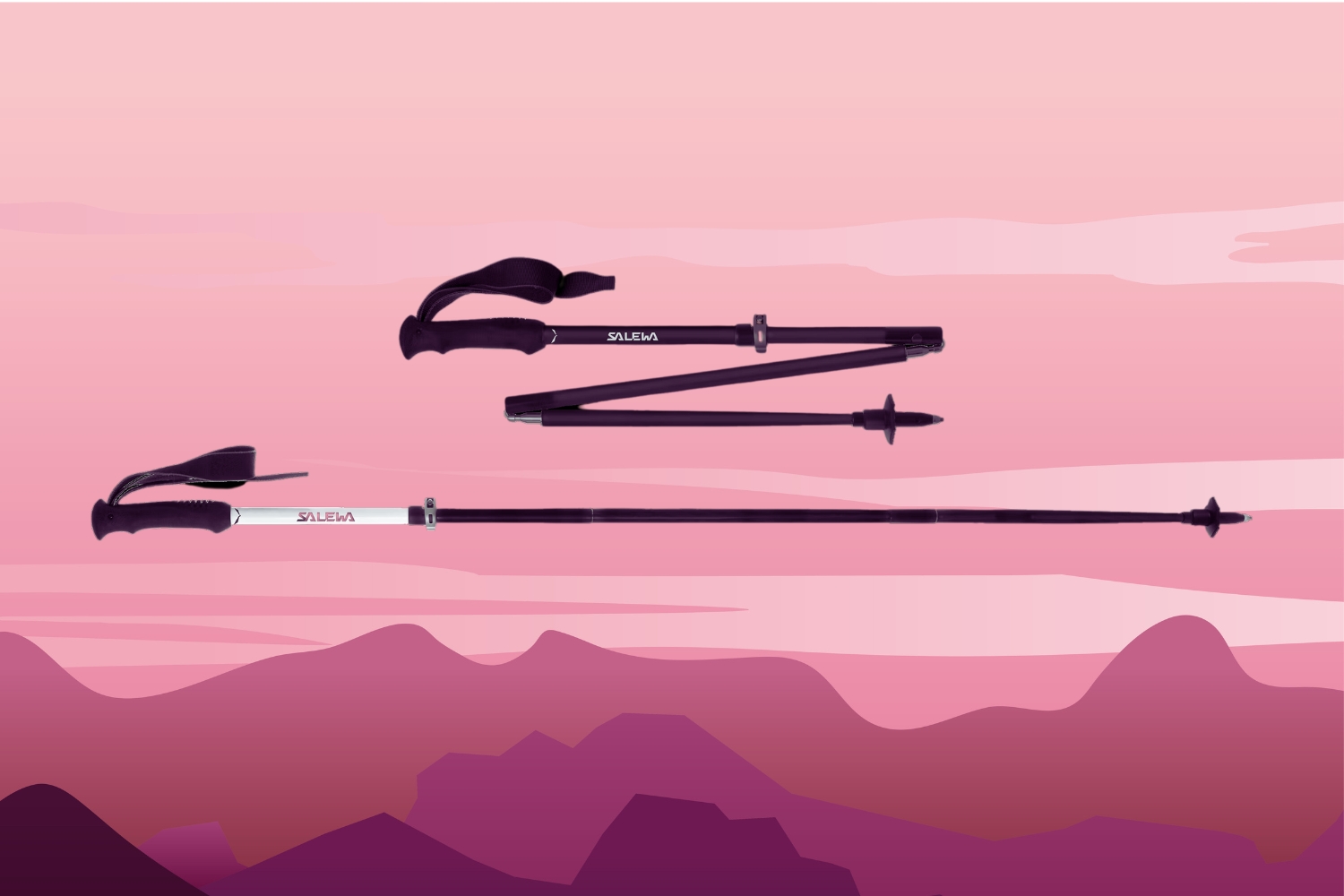
Average Price: $ 185 USD
Available Lengths: 105 – 125 cm
Weight (pair): 16.86 oz / 478 g
Pole Material: Carbon and aluminium 7075
Pros:
Trek Pro Foam 245 grip – especially lightweight and pleasantly soft for best wearing comfort
Comfort Padded Strap – especially soft strap, comfortable to wear
Powerlock 3.0 – our strongest lock made of forged aluminium
FXP folding mechanism – the first and only self-deploying mechanism with a solid connection of the individual segments, a mechanical connection and 30% less weight
Cons: A little short at its maximum deployment compared to other poles
The CARBON FXP APPROACHCOMPACT has an extraordinary design that will help you a lot when it comes to undertaking long walks on winding and vertical trails, providing you with the greatest efficiency when carrying heavy weights on your back, it has a good cushioning system at the tips of the Canes. The grips are ergonomic that allow a good hold even when your hands are very humid due to drizzle or body sweat.
Its manufacturing of materials guarantees a long duration even using it almost every day, since it has much improved stick adjustment systems compared to other similar products on the market. It is also easy to transport in your backpack or bag, since it can be folded very easily.
With this walking stick you can comfortably travel the trekking circuits in the Andes such as: Ausangate Trek, Salkantay Trek, Trek to Choquequirao, Quelccaya Glacier Expedition, Lares Trek, Trek through the Inca quarries, Ancascocha Trek, Tour to the ruins of Huchuy Qosqo, the classic Inca trail to Machu Picchu, the Short Inca Trail to Machu Picchu, tours through the Huaraz mountain range, expedition to Patagonia.
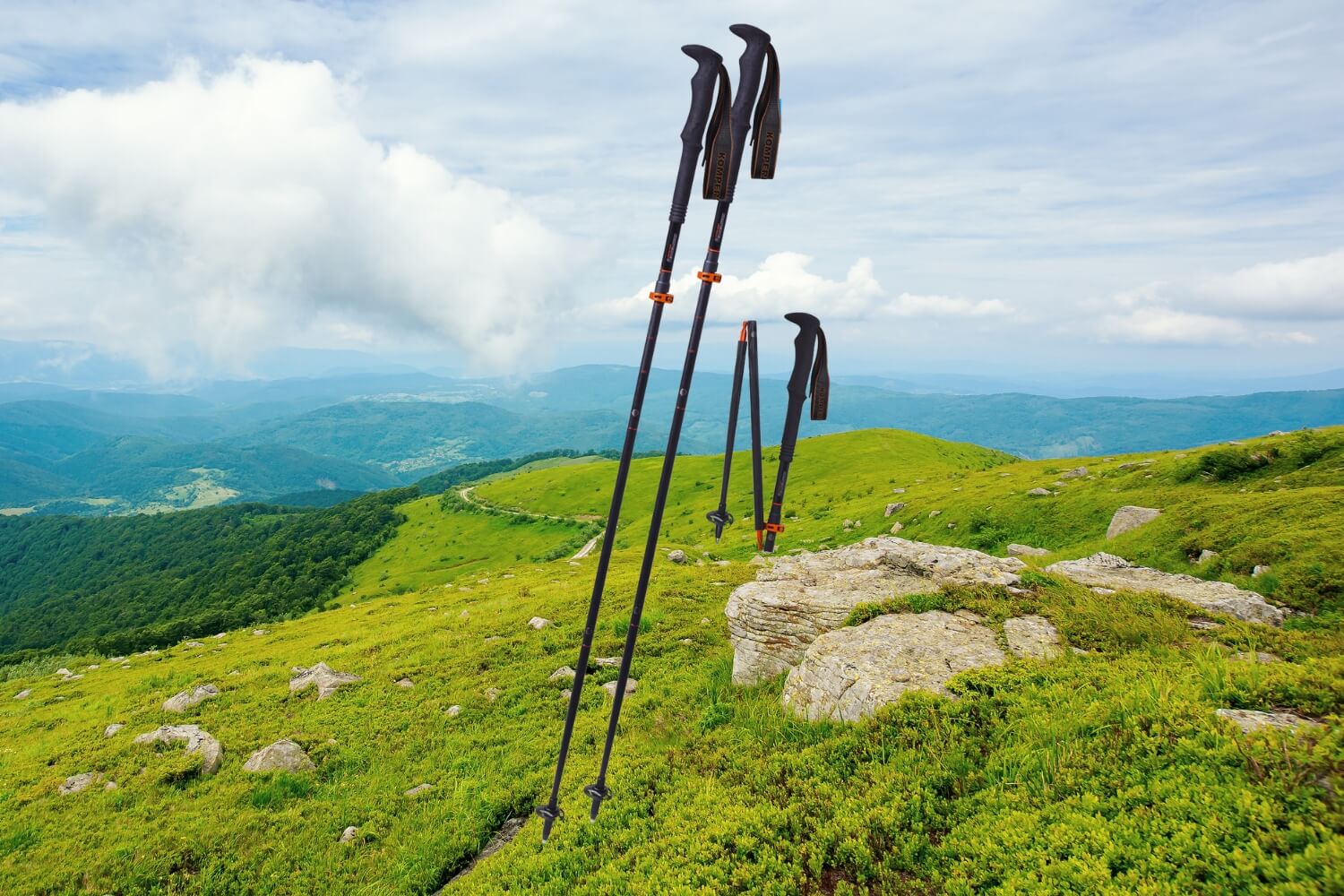
Average Price: $ 102 USD
Available Lengths: 130 cm
Weight (pair): 16.93 oz / 480 g
Pole Material: Aluminum 7075
Pros: Anatomic, non-slip handgrip, Tungsten tip, Trekking wheel included / Silent tip.
Cons: Little flexibility compared to carbon poles
Compared to other trekking poles, they may seem less elaborate and have fewer details, but once in our hands it is surprising how light they are and the consistency of all its components, such as the handle and the cord used for its assembly. The simplicity of its design should not deceive us because, far from being a weak point, Ferrino has achieved sticks that are very easy to handle, not complicated at all, remaining very well tucked away when folded, so that both sticks can be held with one hand no problem.
The remarkable lightness of the Ferrino Zion is due to the material used in its construction: Aluminum 7075, consisting of an alloy (ie a combination) of aluminum with zinc, possibly being the aluminum alloy with the highest performance. In short, it is a material that is characterized by very good resistance, with a high resistance-density ratio, which translates into the remarkable lightness that we notice when picking up the clubs, as we have indicated.
With this walking stick you can comfortably travel the trekking circuits in the Andes such as: Ausangate Trek, Salkantay Trek, Trek to Choquequirao, Quelccaya Glacier Expedition, Lares Trek, Trek through the Inca quarries, Ancascocha Trek, Tour to the ruins of Huchuy Qosqo, the classic Inca trail to Machu Picchu, the Short Inca Trail to Machu Picchu, tours through the Huaraz mountain range, expedition to Patagonia.
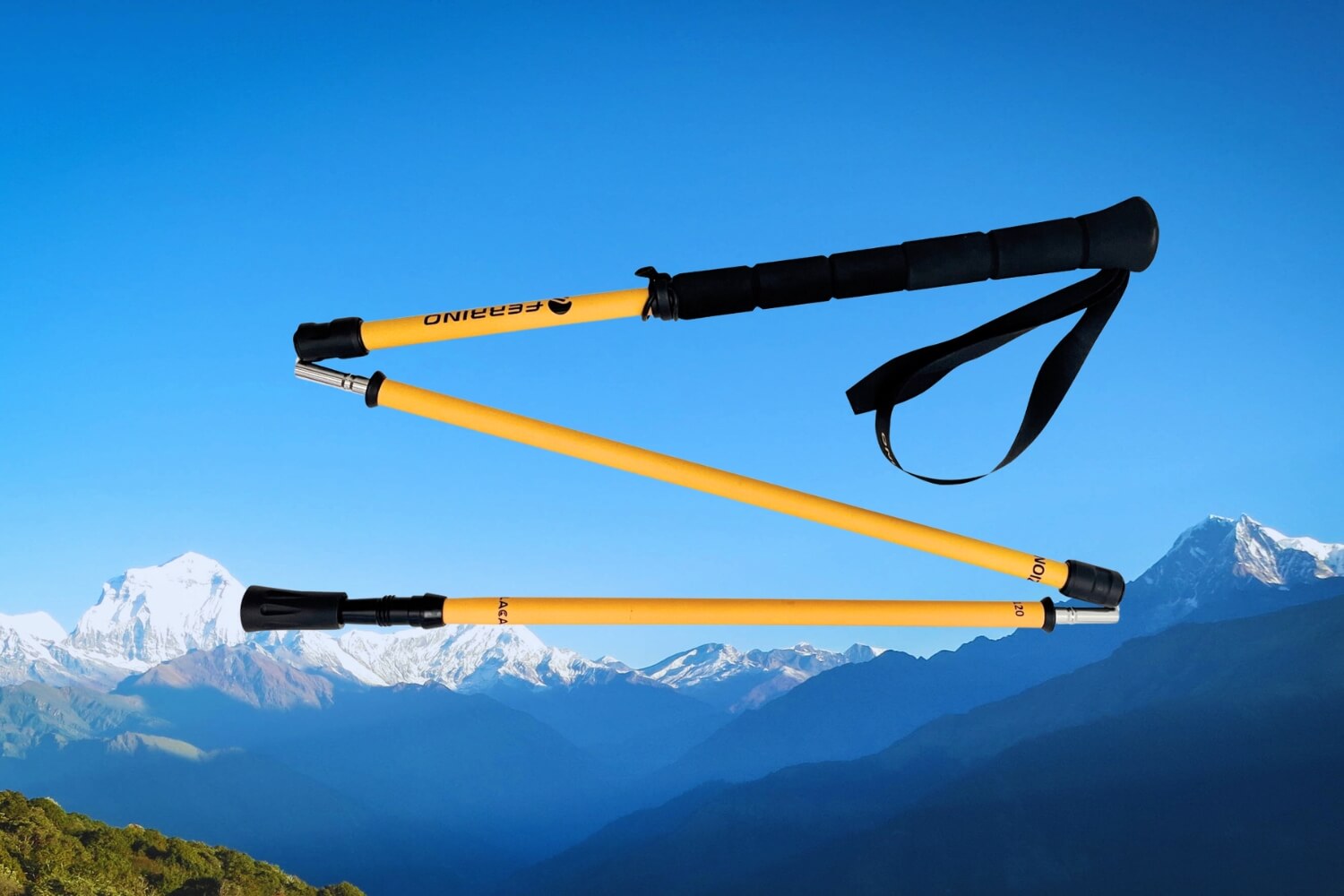
Average Price: $ 120 USD
Available Lengths: 115 – 135 cm
Weight (pair): 20.3 oz / 574 g
Pole Material: 7075 Aluminum
Pros: Foldable aluminum trekking poles, Carbide tips, Easy to assemble and disassemble
Cons: Not the cheapest of its kind
The Megasonic is a robust foldable trekking pole that features probe-style construction with larger segments to combine the practicality and compactness of the ‘Z-pole’ style with the rigidity and resistance of telescoping poles. Made entirely of aluminum alloy for strength and durability. The soft foam double handle has an ergonomic extension that ensures great grip at different heights. The wrist straps are easy to adjust while moving and are differentiated for right and left hands for optimal comfort. The internal cord is covered in plastic material for fluid assembly and disassembly. The micro-adjustment tensioning system guarantees a tight assembly and the upper segment is equipped with aluminum fast clips for quick, easy, and secure length adjustment.
With this walking stick you can comfortably travel the trekking circuits in the Andes such as: Ausangate Trek, Salkantay Trek, Trek to Choquequirao, Quelccaya Glacier Expedition, Lares Trek, Trek through the Inca quarries, Ancascocha Trek, Tour to the ruins of Huchuy Qosqo, the classic Inca trail to Machu Picchu, the Short Inca Trail to Machu Picchu, tours through the Huaraz mountain range, expedition to Patagonia.

Average Price: $ 196 USD
Available Lengths: 110 – 130 cm
Weight (pair): 16.22 oz / 460 g
Pole Material: Carbon
Pros:
Bevelled Tungsten tip for extraordinary grip on icy snow.
Optimized geometry to eliminate bunching
Lowered washer compared to other tips on the market for perfect lift-off
Good travel and inclination thanks to the specific shape of the puck
Cons: Not recommended if you are going to buy it for a single event
A silent and respectful of nature and the terrain, it adapts during walking to different roughness whatever the type of ground encountered for extraordinary support and grip. No more toes, no more removable PAD to remove/replace while walking, the Crossover Pad adapts throughout the duration of the walk to the different roughness whatever the terrain encountered for extraordinary grip and support. The 8 studs deform on contact with the ground to adhere, grip and stick as close as possible to the ground.
External adjustment system offers excellent resistance to all atmospheric conditions and allowing reliable and fast adjustment. Stick folding system for minimal bulk and quick deployment. Its construction as well as its perfect adjustment between the different sections, provide excellent resistance and stability. Thanks to its magnetic, magical, playful and unique technology, attaching your gauntlet to the stick becomes child’s play. No need to aim well to hook it, it’s the stick that comes to you. Secured and locked, there is no risk of accidental detachment during walking. A simple press on the top of the handle is enough to free yourself from the stick.
The ergonomic gauntlet provides real support, comfortable and precise. Its breathable and comfortable fabrics as well as its numerous reinforcements around the perimeter contribute to a reactive recovery of forces and precise support.
With this walking stick you can comfortably travel the trekking circuits in the Andes such as: Ausangate Trek, Salkantay Trek, Trek to Choquequirao, Quelccaya Glacier Expedition, Lares Trek, Trek through the Inca quarries, Ancascocha Trek, Tour to the ruins of Huchuy Qosqo, the classic Inca trail to Machu Picchu, the Short Inca Trail to Machu Picchu, tours through the Huaraz mountain range, expedition to Patagonia.
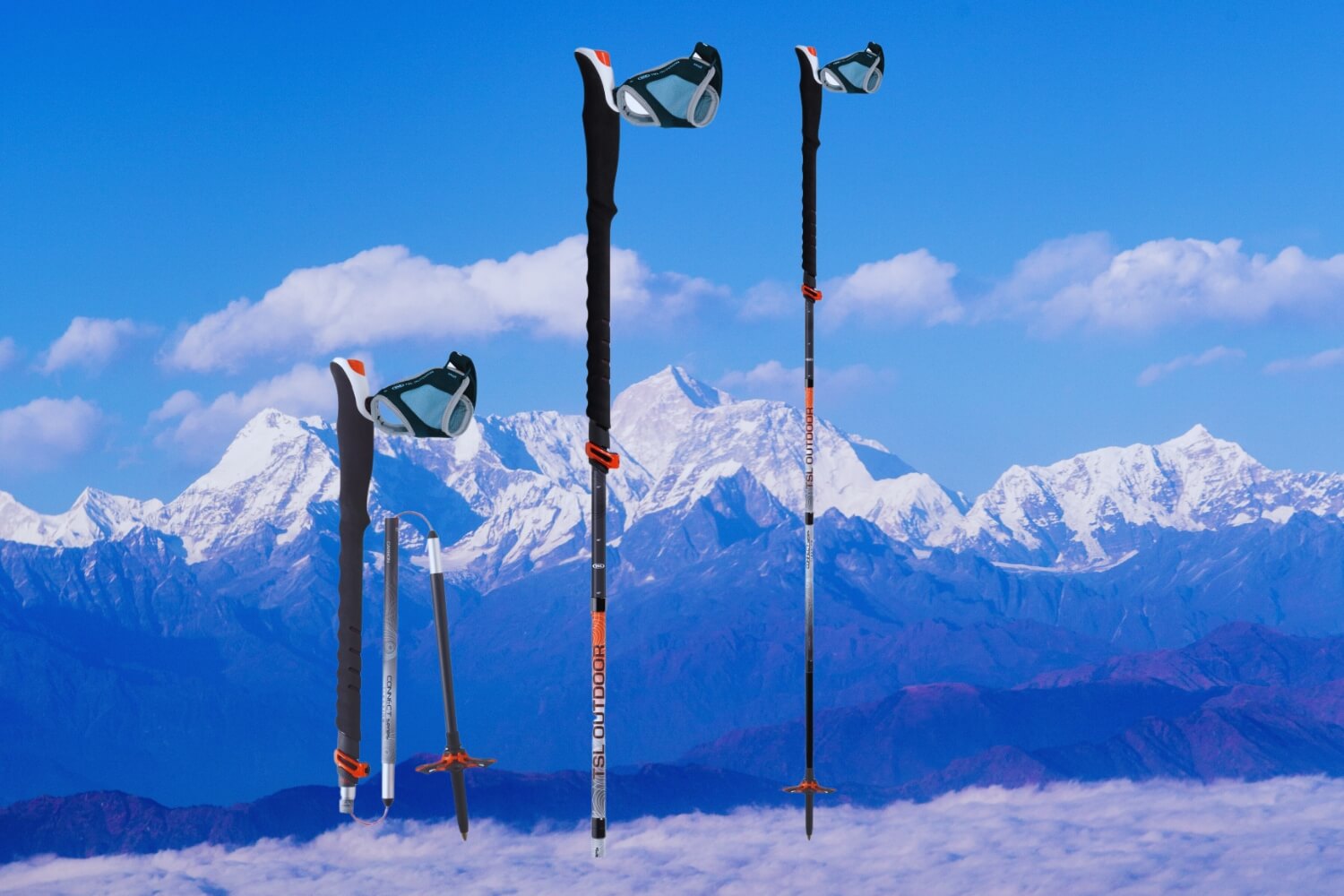
Average Price: $ 209 USD
Available Lengths: 100 – 130 cm
Weight (pair): 16 oz / 465 g
Pole Material: Carbon fiber
Pros: Comfortable grips, Extremely packable, Excellent locking Mechanism, Lightweight and versatile construction
Cons: No range of length adjustment, Expensive, Not super light
The Alpine Carbon Cork Trekking poles are a very practical, sleek and easy to use. The Poles are 4 season trekking poles and so are good for use any time of year.The hand grips of the poles are of course, as per the name, made from cork. They are very comfortable and fit well into your hands. The hand grip also features a 360 degree sewn strap, for wrapping around your hand. The poles also feature an extended non-slip EVA foam grip extension just below the handles. These are used for quick height adjustment as you hike without adjusting the flick locks. The grip extension makes this really easy to do.
The poles also feature Black Diamonds Flex tech tips which are designed in such a way as to break away if you get caught in something. The tips are fully replaceable which is also a great to have in terms of longevity of your poles. they can also be swapped out to the rubber tech tips from Black Diamond (sold separately) if you prefer them. The poles also come with wider powder baskets, which can be easily attached by screwing them on to the poles. Good for hiking in snow and that type of thing. The pole height is adjusted by using a flicklock locking mechanism. You simply open the lock, and adjust the pole to your desired height.
With this walking stick you can comfortably travel the trekking circuits in the Andes such as: Ausangate Trek, Salkantay Trek, Trek to Choquequirao, Quelccaya Glacier Expedition, Lares Trek, Trek through the Inca quarries, Ancascocha Trek, Tour to the ruins of Huchuy Qosqo, the classic Inca trail to Machu Picchu, the Short Inca Trail to Machu Picchu, tours through the Huaraz mountain range, expedition to Patagonia.

Average Price: $ 65 USD
Available Lengths: 110 – 130 cm
Weight (pair): 10.79 oz / 306 g
Pole Material: Carbon Fiber + Aluminum 7075
Pros: Non-slip and comfortable grip, high flexibility, cobalt tungsten tip
Cons: Not recommended for ski adventures
The Aonijie Vertical Z trail poles are made of carbon fiber and aluminum alloy, thus offering lightness and resistance at a high level. The ability to fold makes this trail pole perfect for travel, as it has a compact design and is easy to slip into a bag. It is light and easy to use both uphill and downhill.
The cane has a soft non-slip EVA handle with linear cuts, which will fit your hands very well, sweat absorption occurs naturally. It has a very durable cobalt and tungsten tip that withstands gravel and rough surfaces with optimal handling. Grooves in the toe grip the ground for stability and confidence while trekking. This cane also has a Dyneema cord, whose fiber fabric has high resistance, reinforced stability and durability.
The leash is adjustable to the wrist, to control your stick, which helps to improve your resistance during your outings. This pole has a quick lock system, which improves ease of use when mounting the pole. Perfect for those who are new to the use of mountain poles.
With this walking stick you can comfortably travel the trekking circuits in the Andes such as: Ausangate Trek, Salkantay Trek, Trek to Choquequirao, Quelccaya Glacier Expedition, Lares Trek, Trek through the Inca quarries, Ancascocha Trek, Tour to the ruins of Huchuy Qosqo, the classic Inca trail to Machu Picchu, the Short Inca Trail to Machu Picchu, tours through the Huaraz mountain range, expedition to Patagonia.

Average Price: $ 195 USD
Available Lengths: 110 – 130 cm
Weight (pair): 10.93 oz / 310 g
Pole Material: Carbon fiber
Pros: Ultralight, comfy handles, easy to adjust, very durable for the weight
Cons: Expensive, carbon fiber isn’t as tough as aluminum
The Gossamer Gear LT5 carbon fiber trekking poles are incredibly light and comfortable. The LT5s are pretty pricey, but the excellent strength-to-weight ratio makes them worth the cost for anyone covering long distances with a light load. These are some of the lightest trekking poles in the world. Designed to support tired legs, these poles are the perfect balance of weight and strength for people who are extremely committed to having the lightest weight equipment.
These hiking poles rely on a simple twist-lock mechanism to secure the poles pieces and adjust the length. This makes it easy to separate the three pole segments for easy and lightweight transport and fasten them together when you’re ready to hike. Ergonomic and Supple EVA Foam Handle – Gossamer Gear did a phenomenal job giving the pole handles enough body to be supportive and offer excellent grip while still keeping them lightweight and easy to handle.
These three-piece telescopic trekking poles are the more compact version of GG’s famous twist-lock Lightrek (LT4/LT3) poles. With a design that makes these poles easy to unpack and adjust, they’ve quickly become a favorite ultralight telescopic trekking pole. The LT5s do sport a decently long grip that should cater to a variety of grip styles and hopefully circumvent the need for constant height adjustments to the shaft. The length of the LT5s is adjusted via a relatively simple internal twist lock system; all you’ll need to do is extend each section to your desired height and then using two hands, grasp both sections and twist them together to tighten.
With this walking stick you can comfortably travel the trekking circuits in the Andes such as: Ausangate Trek, Salkantay Trek, Trek to Choquequirao, Quelccaya Glacier Expedition, Lares Trek, Trek through the Inca quarries, Ancascocha Trek, Tour to the ruins of Huchuy Qosqo, the classic Inca trail to Machu Picchu, the Short Inca Trail to Machu Picchu, tours through the Huaraz mountain range, expedition to Patagonia.

The market for trekking poles has become increasingly populated by models that range vastly in price, quality and purpose. Whether you’re thru-hiking across the country or heading out on a quick weekend jaunt, trekking poles can add a lot of stability and comfort to your hike. Trekking poles aren’t essential, but many backpackers love them for a variety of reasons. They help reduce impact on your knees, increase balance on difficult terrain or while fording rivers, and some hikers use trekking poles to pitch ultralight tents.
A decade ago, it was considered a luxury to hike with trekking poles, something reserved for only the most serious of hikers. As time has gone by, the benefits poles provide have been realised by your average hiker looking to gain in comfort, balance and stability as well as to prolong the health of their joints.
Do you want to buy trekking poles for hiking, day trips or running in the mountains but are hesitant because there are so many types and styles available?. Many trekking poles are pretty similar in design, so it can be a daunting task to find you perfect pair. Adjustable or not, folding or fixed, light or more robus. If you choose well, you will save a lot of time and money. Below are the main differences between the different models of sports poles, along with tips for choosing the one that is best for you. Here are the key features you should look out for when buying trekking poles.

When shopping for trekking poles, there are three common designs to choose from: fixed-length folding poles, adjustable-length folding poles, and fixed-length non-folding poles.
They fold up into three or four sections to make them short and easy to store when not in use. Folding poles are made of three to four sections of either carbon fiber or aluminum, with a cord threaded through the center of each piece. When the pole is extended, the cord tightens and the pieces lock together at reinforced joints, creating a stable, secure pole. When not in use, the poles fold up, allowing for easy storage your backpack. Folding poles can be found in fixed-length and adjustable-length versions, those poles have an extra sliding section that can extend their length by 10 to 20 centimeters.
With adjustable poles, you can quickly change the length. This lets you fine-tune them on the trail to your personalized height. You can adjust them if you’re exhausted and want to transfer a bit more weight to your upper body. Adjustable poles give you the option to extend or retract on the descent or on steep ascents. The downside is an increased possibility of failure or slippage at the locking points, especially with twist locks.
Are one solid piece, much like a traditional ski pole. This poles are usually the lightest poles available as they do not need the extra materials required for the construction and mechanics of folding poles. These poles are difficult to store on a pack, however, so you will need to carry them in hand throughout the duration of a hiking; which can be inconvenient on long sections of long hiking days. Fixed-length non-folding poles work best in settings like uphill-only events such as vertical kilometer races where the poles will be in use for the entirety of the run. Because their versatility is much lower than folding poles, there are very few options available for purchase. The light weight, and simplicity of fixed-length folding poles make these a very popular choice for ultrarunning and trail running.
Fixed-length poles don’t offer as much fine-tuning but can generally handle a lot of weight and they have less room for error. Generally, fixed-length poles are more ideal for trail running and other fast-paced endeavors where adjustments will only slow you down.
Telescoping poles made of two or three sections are the most common type on the market, and are known for their durability and ease of use. As such, they’re popular with everyone from day hikers to backpackers and even mountaineers. The different pole sections expand from each joint by a locking system that can be opened for adjustment and secured while on the trail. These points of connection also are their greatest weaknesses, so a quality locking mechanism is highly recommended (we discuss this in more detail below). In this category, we prefer light poles with simple feature sets: secure locking mechanisms, quality aluminum or carbon fiber construction, and comfortable grips.

The ability to pack your trekking poles largely depends on the type of trek you intend to do. If you’re only doing day hikes, you can always expect to have your poles in your hands, while if you’re traveling by various modes of transport between hikes, you may prefer poles that don’t take up a lot of space and can fit in your backpack. Z-style poles are the most portable and are often called “tent poles” because of the way they break and fold. While the most portable, these poles will lack durability, as they essentially separate at more points than the typical telescope pole that simply slides on itself.
Not everyone places such a high value on a compact size, which is partly why three-section poles remain the most popular style on the market. Its average minimum length is 24 to 27 inches, which is small enough to fit on the outside of a backpack pack and can also fit in most luggage. Two-section telescoping designs can make it a pain to squeeze into a duffel bag or suitcase, and you can forget about traveling with a fixed-length pole.
Weight is an issue for everything in hiking, from boots to backpacks to jackets. Typically when you gain weight you lose durability and this is largely true of trekking poles. Carbon fiber poles are the lightest, but they don’t quite match the durability seen in aluminum poles. Weight should be a primary consideration when determining the best trekking pole for you. Similar to the theory behind walking shoes, every ounce matters when you raise your arms thousands of times a day. If you normally only take short day hikes or do a lot of winter walking, a heavier, more durable pair of aluminum poles may be more practical.
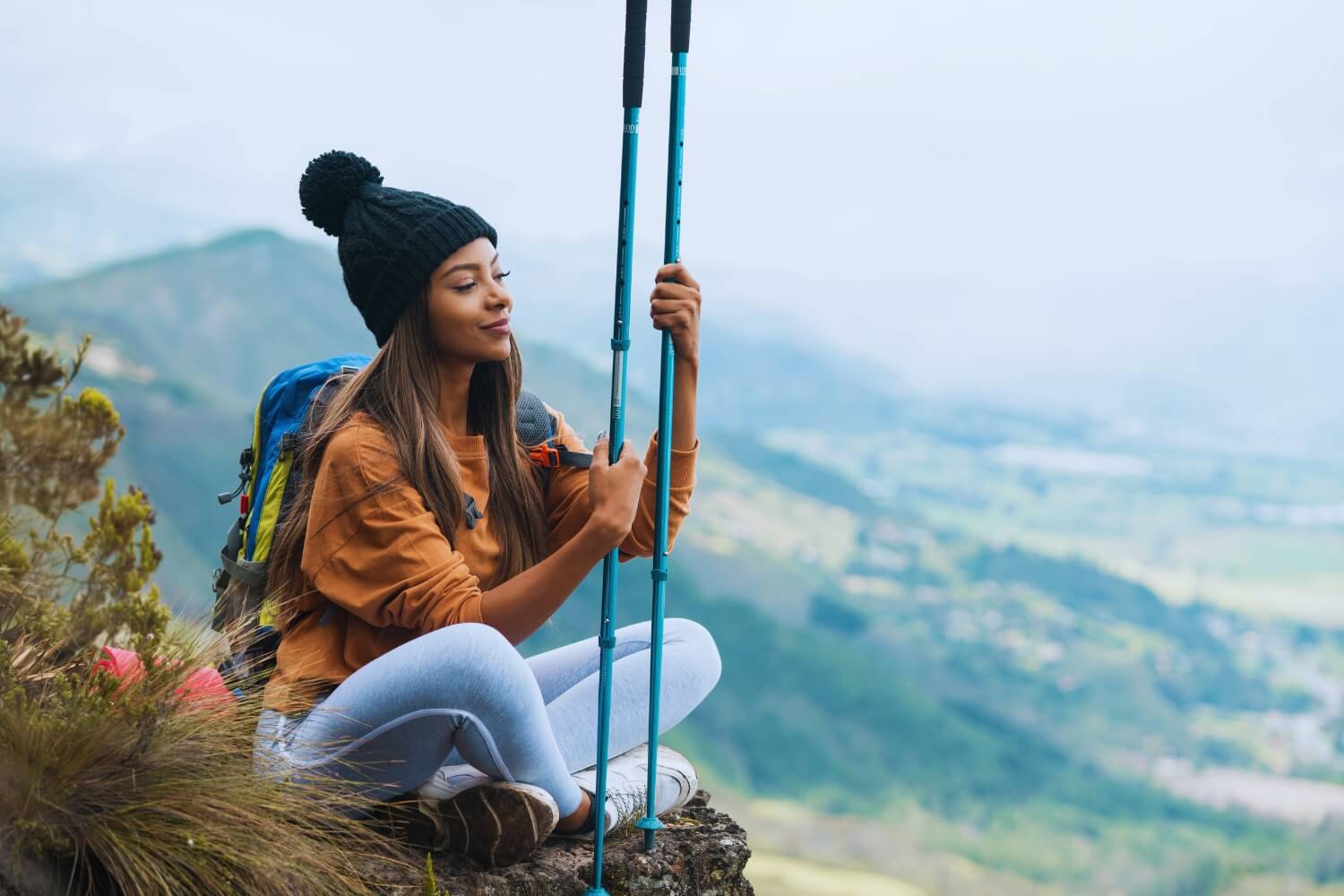
There are many great aluminum and carbon poles on the market. When deciding which type of poles is right for you, the biggest factors to consider are budget, the amount you will be using them, and how you plan to utilize them. Carbon fiber poles are lighter and more energy efficient, but they tend to be less durable over the long run. Aluminum poles are heavier, but they tend to be the more durable option and will bend before failing completely. This is why some manufacturers make a hybrid carbon and aluminum pole with the aluminum section at the bottom.
You can hike faster with carbon fiber trekking poles. Carbon fiber trekking poles are more efficient. Many hikers find carbon fiber poles to be more comfortable than aluminum. The reason is that carbon fiber does a better job of damping vibrations. The material has natural vibration damping qualities. When you lean on your carbon fiber trekking poles, they don’t flex. This gives the poles a more supportive feel when the pole hits a surface. Carbon fiber trekking poles tend to be a bit higher-end than aluminum. They often have a bit better fit and finish. The grip and strap may be more comfortable.
Carbon fiber is a more fragile material than aluminum. If you accidentally hit the side of your pole against a rock or bang your poles together too hard, you can crack the carbon fiber. This weakens the pole and can cause it to fail. An impact force that wouldn’t damage an aluminum pole may destroy a carbon fiber pole. Carbon fiber poles can also crack if they are bent too far from side to side. Carbon fiber is really only strong in one direction (top to bottom). When you bend it sideways, it can crack fairly easily. It’s easy to accidentally bend a pole when it gets caught between rocks or when you lean on it too hard. The resin that holds the carbon filaments together can also fatigue and degrade over time.
The epoxy used to bond the carbon fiber sheets together can be sensitive to cold temperatures. It may become brittle if it gets too cold. This makes the poles easier to crack. This doesn’t’ mean you can’t use carbon fiber trekking poles during the winter. You just have to be a bit more careful and choose the right ones. If you’re hiking during the winter, you may want to choose less engineered models. In other words, choose models that don’t fold or telescope. Fixed-length poles handle the cold better. Higher-end models with modern epoxies also perform better in cold conditions.
The best and most common aluminum used to make trekking poles is 7075. This aluminum alloy offers strength, durability, and fatigue resistance. An aluminum trekking pole will slowly start to bend before it breaks. It won’t suddenly crack in half like a carbon fiber pole can. Aluminum trekking poles give you a bit of warning before they fail. This property of aluminum keeps you a bit safer.
Aluminum trekking poles can handle harder impact forces without sustaining damage. If you hit your aluminum trekking poles on a rock or knock them together, chances are they’ll be just fine. They can also handle heavier weight and stronger flexing forces as you hike. This is great for hikers who are on the heavy side. Aluminum poles also aren’t affected by abrasions. If you scratch your aluminum poles, they’ll be fine.
The superior durability of aluminum trekking poles makes them more reliable. Even cheap, low-end models offer good reliability. The benefit of more reliable poles is that you don’t have to worry as much about them failing mid-hike. A good pair of aluminum trekking poles should last you many years. Even cheap aluminum poles last a long time. This saves you money as well because you won’t have to replace your poles as frequently.
Aluminum trekking poles are less comfortable to use. The reason is that they can’t absorb vibrations as well due to the higher density. The vibration makes your hands and arms fatigue faster. After a long day of hiking, you may have a buzzing feeling in your hands, like you’ve been operating power tools all day. You may not want to use your aluminum trekking poles as long or as often for this reason. There are a few ways to improve comfort. You can wear gloves. You can also choose trekking poles with a comfortable grip material and shape. Many hikers like cork grips with an ergonomic shape. Some trekking poles also have a built-in shock absorption system. This is basically a spring built into the tip of the pole. This can also help reduce vibrations.

Whether adjustable in length or not, all trekking poles have locking mechanisms to prevent the poles from slipping while in use. For non-adjustable poles, the mechanisms lock and unlock so you can extend them to their full length for use and fold them down for storage. Adjustable posts work in a similar way, but the locking mechanisms also allow you to adjust the length of the two or three interlocking sections.
External Toggle Lock : A lever-based, clamp-like mechanism that makes pole length quick and easy to adjust, even while wearing gloves.
Push Button Lock: Posts with this locking mechanism snap into place and lock with a single pull. Press the button to release the lock and collapse the posts. Some of these poles do not adjust in length.
Twist Lock : Uses an expander and screw configuration that is consistently strong and durable.
Combination Padlock : Some posts use a combination of other locking mechanisms to strike a balance between strength, light weight, and ease of use. For example, a post might use an external lever lock on the top spindle and a twist lock on the bottom spindle.
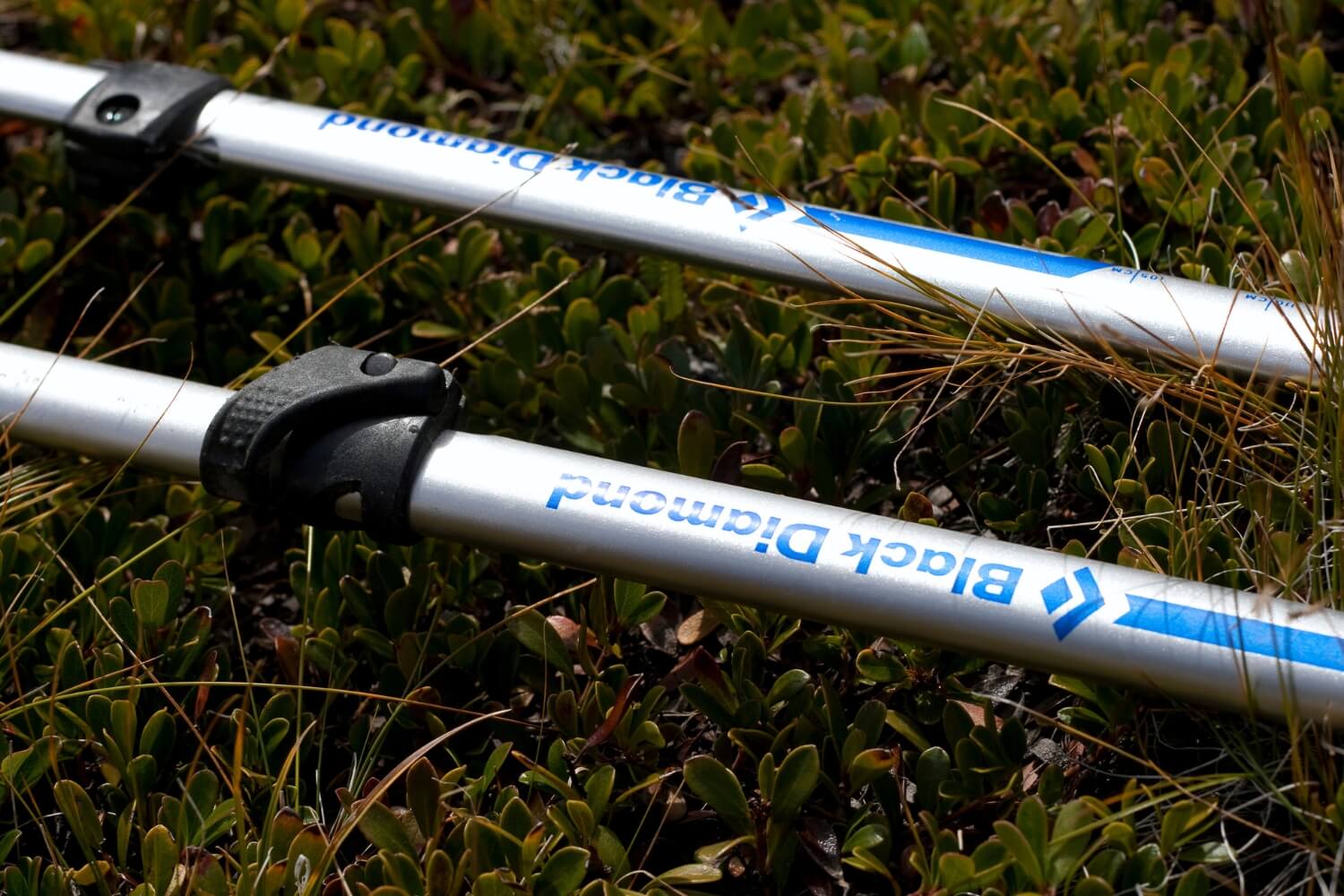
Some canes and walking sticks include ergonomic grips that have a 15-degree corrective angle to keep your wrists in a neutral, comfortable position. Also, some hiking poles have grips that look similar to what you would find on a walking stick. This shape provides good support for casual walks and very light hikes. Grips come in a variety of materials that affect the feel of the poles in the hands.
Cork: Resists moisture from sweaty hands, decreases vibration, and better conforms to the shape of your hands. Cork grips are the most popular grips found on trekking poles. It molds to the shape of your hand and has a comfortable, natural feel. It is the middleweight option of the three grip types and is not often found on ultralight poles.
EVA Foam: Foam is the lightest material used in the grips and feels comfortable in the hand. Absorbs rain, sweat and dirt. So it can get fluffy when wet, but it dries quickly. Foam is also less durable than cork or rubber.
Rubber: Rubber is the heaviest on the list, but is highly prized by hikers. Unlike foam, it does not absorb water or oil from your hands. It also provides some insulation for your hands, making it better for winter sports like snowshoeing or skiing. This insulates your hands from cold, shock, and vibration, making it better for cold-weather activities.
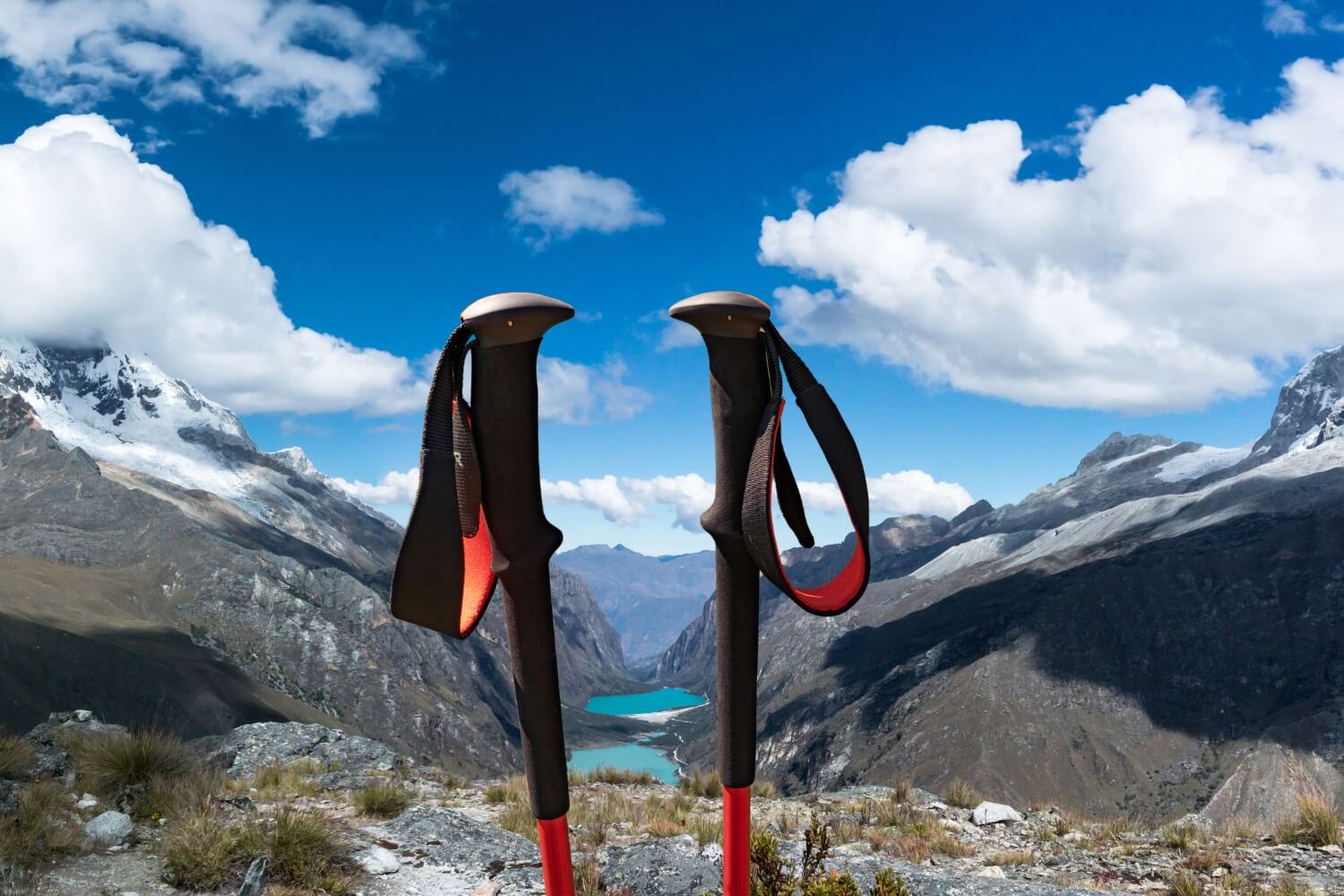
Wrist Straps: Slipping your hand under the wrist strap and then gripping the grip around the strap will save you from having to grip your trekking poles as tightly. To use them correctly, run your hand through the bottom of the strap, then pull down and grasp the handle of the cane. This technique supports the wrist and heel of the hand and allows you to keep your hand relaxed in the grip.
Baskets: Trekking poles usually include a small removable trekking basket at the tip end. They are useful for winter activities and hiking activities in the Andean mountains. The wider the basket, the more they will prevent you from stabbing into the ground. Large baskets are great in the snow, but not necessarily useful in warmer weather. Naturally, they make a pole a bit clunkier and heavier and can become entangled in vegetation on the trail as you walk.
Shock Absorption: The shock absorbers prevent some of the impacts from repeatedly hitting the ground with the poles from traveling to the hands. Some people like that extra flex, while others find that the extra inch or two of spring movement makes them feel wonky.
Camera mount: Some trekking poles have a top handle that unscrews and allows you to thread your camera’s tripod mount.
Tents with Trekking Poles: Many ultralight tents require trekking poles to set up. They save weight since it is not necessary to carry tent poles.
Post Tips: Carbide or steel tips are commonly used to provide traction, even on ice. Rubber tip protectors extend the life of the tips and protect your gear when the poles are stored in your backpack. They are also good for use in sensitive areas to reduce impact on the ground. Angled rubber walking spikes (usually sold separately) are for use on asphalt or other hard surfaces.

Most hikers start using trekking poles quickly and adopt the proper rhythm of planting the opposite trekking pole at the same time as the opposite foot (right foot, left pole, left foot, right pole, etc.). If you lose your rhythm, just keep walking while lifting the poles off the ground for a moment so you can restart. Start planting the poles again as soon as you are ready. Soon this will become completely natural and you won’t even have to think about it.
From time to time, you may want to plant both poles at the same time and then take two steps, plant both poles again, and continue. This can be beneficial on steep climbs or descents where you need the stability of both poles on the ground at the same time.
When using trekking poles, it is best to walk naturally and maintain a natural swing of your arms as if you had no poles in your hands. The poles can be angled slightly behind you so that when you plant them you can propel yourself to assist your forward movement.
Stream and River Crossings: Trekking poles provide much-needed stability when you have to wade through water. Make sure that each time you plant your pole, it is secure at the bottom before moving forward. If the water is deep, lengthen your sticks.
Puddles: You can maneuver around them, using your poles for stability, or you can “pole vault” the other way by planting both poles and jumping over them.
Large Rocks: To get up and over large rocks, the poles can give you a useful push. To do this, plant both posts in the ground and as you climb up the rock, push the posts in to reach up to the rock.
Logs: To climb over a log, simply plant the poles in the ground and use them for stability. If you are walking on a log to cross the water, you can use the poles to improve your balance by extending them to either side (imagine a tightrope walker using a large pole for balance).

The following table makes it easy to determine the exact length to select or adjust for your walking stick. Choose or set the length of your cane according to your height. While it is quite easy to choose the right size, it is very important that you do so in order to get the most out of your cane. If the cane is at the right height, it will protect you from wrong movements and prevent you from falling. The forearm should be at 90 degrees once you have fixed the tip of the cane to the ground:


Ausangate is home to some of the most breathtaking natural wonders on earth. A must visit is Sibinacocha Lake. Top to bottom, you’ll see a glorious storyline of mountains, including a large portion of the Andes buried under centuries of ice and snow, as well as, glaciers, glacial lakes, and lush andean valleys.

The Ausangate Trek is renowned for its otherworldly natural scenery. It’s considered by many to be one of the world’s best high-altitude treks, the trek takes hikers over several high passes, into low alpine valleys, and through traditional Peruvian villages.

Explore the Manu Amazon Rainforest & Inca Trail hike to Machu Picchu, you will enjoy the best adventures in Peru, exploring amazing inca trail routes and the best amazon wildlife with our local tour guides, in small groups.

Enjoy an incredible vacation, in the heart of the Inca empire, Cusco, our travel program will take you to the most famous tourist attractions of Cusco, such as the Sacred Valley of the Incas, Machu Picchu, in very cozy hotels.

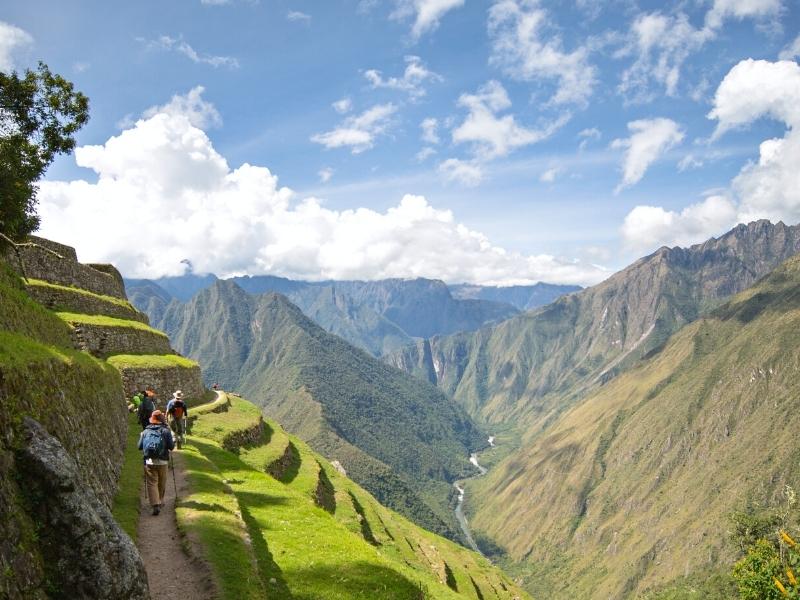
The classic Inca Trail hike to Machu Picchu is one of the world's greatest hikes. Along the 45 km you will explore unique andean valleys, lush mountain forest.An exquisite architecture of the Inca sanctuaries, which will dazzle you for its fineness and location within the Andes.
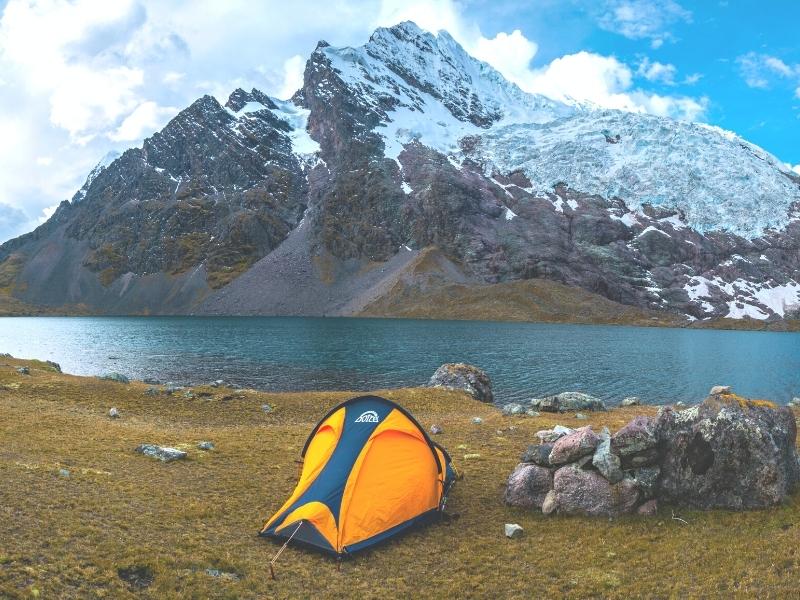
Ausangate is an excellent and quiet/remote trekking circuit offering stunning features such as spectacular mountain scenery, snow-capped peaks, hot springs, turquoise lakes, glaciers, herds of llamas, alpacas, and wild vicuña, picturesque villages, and traditionally dressed Quechua people.